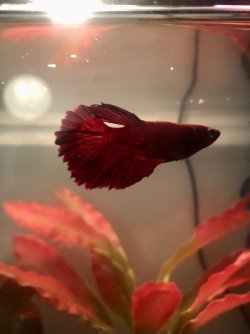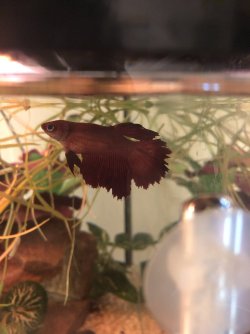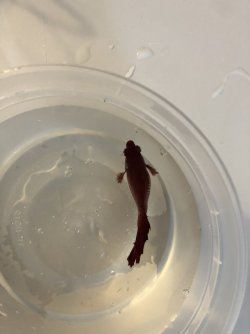corneliusmom
New Member
Hello! I have had my betta for about 4 months, which I rescued from some pretty neglectful conditions (half gallon plastic bowl, no heater or filter, single sharp plastic plant, filthy water). I set him up in a heated an filtered 10 gal right away with 2 hides and a silk plant. The first pic was taken about 10 days after I got him. The second was taken yesterday. Since then, I have made many improvements to his tank; I've bought tons of silk plants, a betta log, switched his filter to a sponge, started him on frozen foods, and recently added live plants.
I recently became concerned, and decided to compare to some old pics. I'm pretty upset. His fins used to be so beautiful and have deteriorated since I’ve had him even though I have been trying my best for him I feel guilty. The water parameters are always within levels (tested yesterday: pH 8, Ammonia 0-0.25, Nitrite 0, Nitrate 0-5), and he does not have any other tankmates. Any ideas what this could be? Is it fin rot?
I feel guilty. The water parameters are always within levels (tested yesterday: pH 8, Ammonia 0-0.25, Nitrite 0, Nitrate 0-5), and he does not have any other tankmates. Any ideas what this could be? Is it fin rot?
I need to mention that I also became concerned a month ago about how fat he seemed even though I was really cutting back his food, and by the fact that his stomach seemed to bulge out more on one side (pic 3). I posted on another forum asking if it looked like a tumor or early dropsy, and someone answered saying it looked like Mycobacterium (fish TB). To be honest, I didn't give it too much thought since he wasn't acting sick in any way, was equally active and equally a glutton. He also has a slight spine curvature; I figured it might just be pushing his organs out. The commenter suggested switching him to live foods which I did. I resolved to just keep dieting him and monitoring him extra closely. His behavior has still not changed, but his stomach looks the same. In light on his fins deteriorating despite my water conditions being good, I am wondering whether he is actually suffering from something.
I am really concerned and want my fish to be well. Please give me your opinions!



I recently became concerned, and decided to compare to some old pics. I'm pretty upset. His fins used to be so beautiful and have deteriorated since I’ve had him even though I have been trying my best for him
I need to mention that I also became concerned a month ago about how fat he seemed even though I was really cutting back his food, and by the fact that his stomach seemed to bulge out more on one side (pic 3). I posted on another forum asking if it looked like a tumor or early dropsy, and someone answered saying it looked like Mycobacterium (fish TB). To be honest, I didn't give it too much thought since he wasn't acting sick in any way, was equally active and equally a glutton. He also has a slight spine curvature; I figured it might just be pushing his organs out. The commenter suggested switching him to live foods which I did. I resolved to just keep dieting him and monitoring him extra closely. His behavior has still not changed, but his stomach looks the same. In light on his fins deteriorating despite my water conditions being good, I am wondering whether he is actually suffering from something.
I am really concerned and want my fish to be well. Please give me your opinions!




 I have another fish tank; what are the precautions I need to take to avoid contamination? I’m afraid I use the same tools (water change, testing etc) for both
I have another fish tank; what are the precautions I need to take to avoid contamination? I’m afraid I use the same tools (water change, testing etc) for both 
